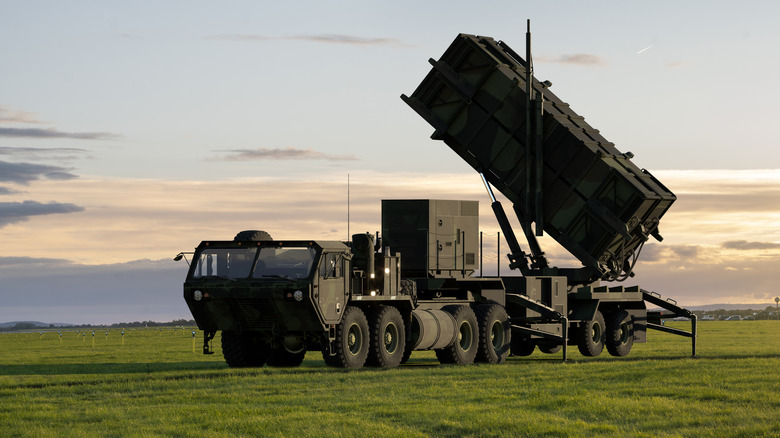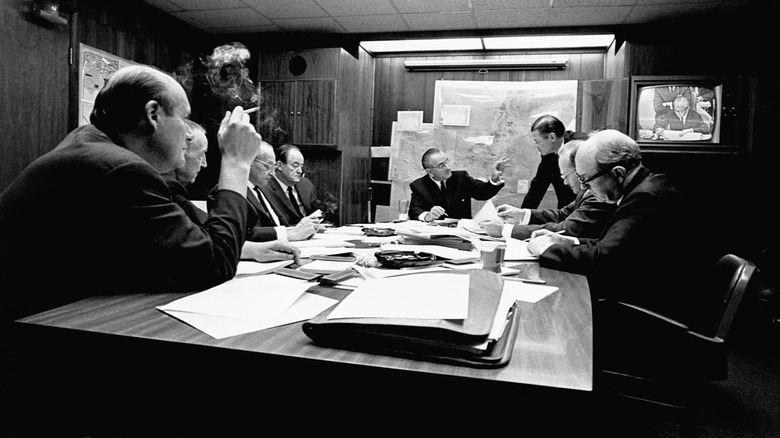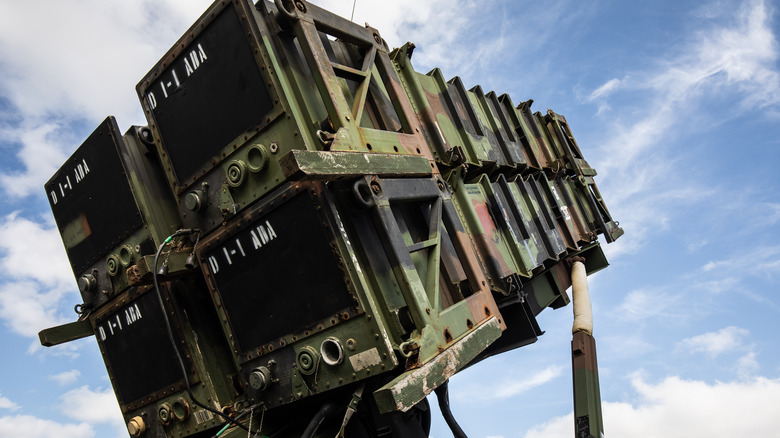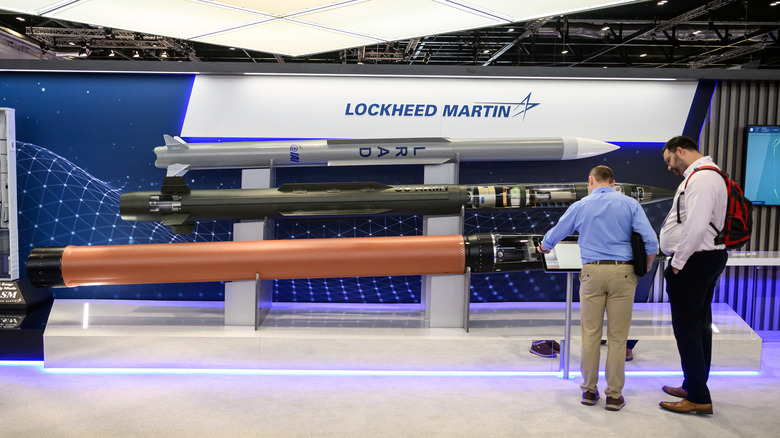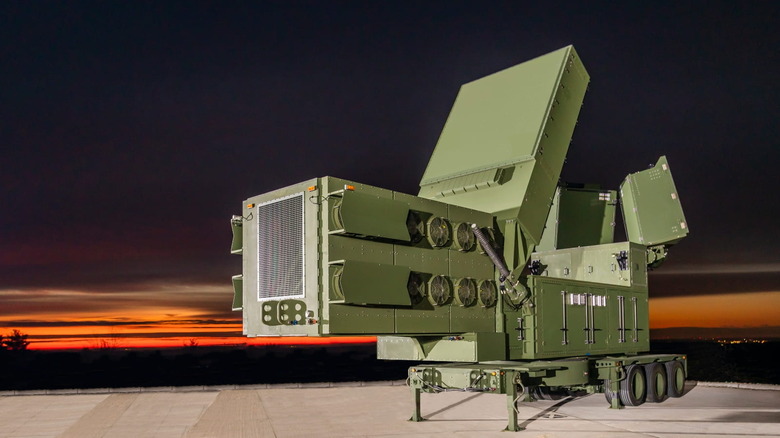What Is The Patriot Air Defense System, And How Does It Work?
When it comes to missile defense systems, few carry as much weight as the PATRIOT system used by the United States and many of its NATO allies. On the face of it, PATRIOT is a highly complex system based around a simple concept. Incoming threats are detected and tracked, missiles are sent off to intercept those threats, and depending on the exact missile used they will either detonate in the threat's vicinity and take it out or impact the dangerous flying object directly.
PATRIOT is an acronym that stands for "Phased Array Tracking Radar to Intercept on Target" and the system was developed by The U.S. Army Missile Command. These days, the system is manufactured by Raytheon, a defense contractor regularly employed by the U.S. Government. The missiles that the system uses are also made by Raytheon — though other contractors including the Martin Marietta Corporation, Boeing, and Lockheed Martin have all been involved in supplying components or missiles. As its name suggests, the system uses radar to detect an incoming threat, then dispatches a missile to take that threat out. There are several types of missile on offer, with cheaper, more primitive, options detonating close to the threat in the hope that the blast and/or shrapnel will incapacitate it. More advanced, expensive, and modern missiles impact the threat directly, increasing the odds of said threat being neutralized while also vastly increasing complexity.
In the west, PATRIOT is arguably both the best known, and most widely spread, missile defense system on the market. It has a long history, and has seen both success and relative failures over the years. Here's everything you need to know about the PATRIOT's past, present, and future.
It's been around for a long time
The origins of the PATRIOT missile defense system actually go way back to the 1960s. It can be traced back to the development of the "Army Air Defense System for the 1970s", which changed its name to "Surface to Air Missile Development" in 1964. The name changed again to the "PATRIOT Air Defense Missile System" in 1976, though this was after the first successful SAM launch. That took place in 1969.
Although PATRIOT has a long legacy, the original missile defense system has little in common with its modern counterpart beyond a name. It's undergone constant updates over the years. In fact, the whole system is arguably a bit like the Ship of Theseus. According to Raytheon, which manufactures the PATRIOT system, everything aside from heaters, cooling fans, and a few other minor parts has been modernized over the last few years. Raytheon itself claims it has "continually embraced new technologies to stay ahead of evolving threats."
This constant upgradability is a feature of the system, which is "flexible and designed in a manner that allows it to be continually upgraded and improved." The company also has a "defined growth path" for the Patriot system, which should see it stay at the forefront of missile defense technology until at least 2048. The constant upgrades make sense when you consider how much military tech has changed over the years. New types of missile, new generations of aircraft, and the increased use of drones are all things PATRIOT has had to adapt to.
The PATRIOT Missile System has been widely adopted
Several of the United States' allies, along with countries that rely on it for military assistance, use the PATRIOT system as part of their missile defenses. A number of these countries are in NATO, including The Netherlands, Germany, Greece, Spain, Poland, Romania, and the alliance's newest member, Sweden. Despite not being part of NATO, neutral Switzerland also buys into the PATRIOT system. The system is also incredibly popular in the Middle East, with Israel, Bahrain, Saudi Arabia, Kuwait, The United Arab Emirates, and Qatar enjoying its capabilities.
Finally, a handful of nations in Asia that are militarily dependent on the United States, namely Japan, Taiwan, and South Korea, have PATRIOT missile systems in their arsenal. PATRIOT has also formed part of several aid packages sent to Ukraine during its ongoing conflict with Russia. The United States has supplied several, along with Germany — but other PATRIOT-possessing European nations have been more hesitant. This may be due to fears of the conflict spilling over into the European Union, at which time the PATRIOT system will be vital to the defenses of the nations that have it. The system itself has been used in over 250 engagements.
In total, nineteen nations (including the U.S.) use the PATRIOT missile defense system. Demand is increasing with global tensions, though the system is relatively scarce. 240 have been built in total, with the majority of those being property of the United States military. Despite ramping up its production capacity, Raytheon can still only build around 12 per year.
PATRIOT has seen both success and failure
The PATRIOT missile system may have failed its first major test. Back in 1991, it failed to intercept an Iraqi Scud missile, which led to that missile hitting a barracks and killing 28 Americans. The cause turned out to be a software issue related to how both the missile and battery keep time. The battery in question had been operating for 100 hours, which led to a roughly 0.3-second difference in its internal clock and that of the missile it was firing. That may not seem like much, but due to the speeds involved, it led to a roughly 600-yard miss. Initial reports claimed that the PATRIOT system intercepted over 97% of all missiles it faced during the first Gulf War, though this was later revised down to 50%. That initial software bug is long fixed, and the system is continuously improving, yet questions about PATRIOT's effectiveness still linger.
However, in the decades since Operation Desert Storm, things have improved a lot. Recent successes in Ukraine have convinced several countries that the system is worth adopting. During the conflict, PATRIOT has intercepted and neutralized a number of targets, including the Kinzhal — a hypersonic missile that sits on the cutting edge of Russia's military capabilities. Missiles have been taken down up to 130 miles away from their intended targets, while fighters including the Su-34 have been shot down by the PATRIOT from up to 100 miles away. In total, five different nations have used a PATRIOT system during a conflict, and there are over 250 recorded combat engagements it has taken part in.
It's far from cheap
Ignoring various laws, if you want to nab your own PATRIOT missile defense system, you may be quite disappointed. According to the U.S. Government, a new PATRIOT missile defense system will set you back around $1.1 billion at the very least. This figure breaks down to around $400 million for the system itself, which consists of the radars and batteries, and $690 million for the missiles. A congressional report released in 2023 suggests that in the future a PATRIOT "battalion," which consists of four batteries, could cost "up to $1.27 billion." This cost does not include missiles, which vary in price. The same report estimates the price of "PATRIOT interceptors" at around $4 million a piece. To put it into context, the missiles used in Israel's "Iron Dome" system cost between $40,000 and $60,000 each.
Missiles also have expiration dates, and while an old can of tuna you find in the cupboard may seem threatening a year or two past its best, the consequences that come with expired missiles are far greater. When a missile is past its best, chemical changes may happen, which will reduce the effectiveness of the propellant, payload, or other components. As engineers discovered during its early deployments, extremely minor changes can mean the difference between success and failure with systems like the PATRIOT. As the system is essentially a last line of defense, failure means key infrastructure, troops, or even civilians may be hit by a missile. So if the system is used, it will need to be reloaded at great expense. If it isn't used, it will still need to be reloaded at great expense after a set amount of time anyway.
The United States has a successor in mind
Despite its recent successes and the fact many of the United States' allies will still be using the system, the U.S. is already developing the PATRIOT's successor. The less catchily titled "Lower Tier Air and Missile Defense Sensor (LTAMDS)" is likely to hit the battlefield within the next few years. Its main battery is around the same size as the Patriot's, but according to developer Raytheon it's "twice as powerful." The 360-degree radar is "designed to defeat advanced and next-generation threats" and can detect and engage "multiple threats from any direction at the same time." As the radar array is vital to a missile defense system's effectiveness, this could indeed be a major upgrade.
These capabilities come courtesy of the three antenna arrays attached to the system. Two are placed at the back, while the primary array is positioned at the front. In terms of targets, the exact "next gen" threats haven't been specifically mentioned, but the system is designed to take out hypersonic missiles — which are about as advanced as it currently gets. The targets in question are capable of moving at speeds exceeding a mile a second.
While the new LTAMDS system will see the U.S. military phase out the PATRIOT system — it isn't the end of the line. Raytheon claims that its new missile defense tech will "also preserve existing military customers' investment in the Patriot system." It will also form part of the United States "Integrated Air and Missile Defense system" which aims to tie together air defensive capabilities across NATO. Raytheon's PATRIOT "growth path" will support the missile system until 2048 at the earliest.
